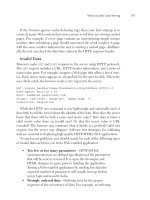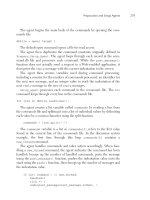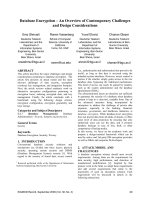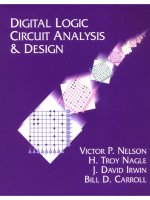DISCRETE-SIGNAL ANALYSIS AND DESIGN- P36 pdf
Bạn đang xem bản rút gọn của tài liệu. Xem và tải ngay bản đầy đủ của tài liệu tại đây (154.57 KB, 5 trang )
ADDITIONAL DISCRETE-SIGNAL ANALYSIS AND DESIGN INFORMATION 161
VC
Vc
•
IL
•
−R/L
−1/C
1/L
I
L(0)
I
L
VC(0)
R
(a)
V
O
1/s 1/s
1.0
1.0
X1(s)
X1(s)
•
X2 X2
•
−R/L
(b)
R
V
O
1/C 1/L
U(s)
1/s
−1/C
1/s
Figure A-4 Flow-chart for the network of Fig. A-2: (a) with no input
(u) but with initial values of V
C
and I
L
; (b) with no initial conditions but
with a sine-wave input signal u(t).
The book by [Dorf and Bishop] explores this problem using several
different methods that are very instructional but that we do not pursue
in this book. The reader is encouraged to become more familiar with the
network analysis methods described in this appendix. It is good practical
engineering.
Finally, Fig. A-4 illustrates the two varieties of ßow graph for the
network discussed in this appendix. We can understand Fig. A-4a by
referring to Eq. (A-5) with u set to zero (no external inputs) and with
initial values of V
C
(0) and I
L
(0), as shown also in Fig. A-2. In Fig. A-4b,
V
C
, I
L
, and their derivatives correspond to those in Eq. (A-5) with initial
conditions V
C
and I
L
set to zero, as shown in Fig. A-3, and the input u
drives the network from a zero start with a sine wave that starts at zero
value. The output peak amplitude V
O
(t) ßuctuates for at least the 1000
time increments illustrated.
It is also an interesting exercise for the reader to calculate and plot
the inductor voltage and current and the capacitor voltage and current as
functions of time n in Figs. A-2 and A-3.
162 DISCRETE-SIGNAL ANALYSIS AND DESIGN
REFERENCES
Dorf, R. C., and R. H. Bishop, 2004, Modern Control Systems, 10th ed., Prentice
Hall, Upper Saddle River, NJ, Chap. 3.
Zwillinger, D., Ed., 1996, CRC Standard Mathematical Tables and Formulae,
30th ed., CRC Press, Boca Raton, FL.
GLOSSARY
Adjacent channel interference. One or more adjacent channel signals
create interference in a desired channel by aliasing or wideband
emissions.
Aliasing (classical). In positive-only frequency systems, a signal in part
of the positive-frequency region is invaded by a second signal that is
in an adjacent part of the positive-frequency region.
Aliasing. The overlapping (invasion) from one 0 to N −1 time or fre-
quency sequence to an adjacent 0 to N −1 time or frequency sequence.
Amplitude noise. Noise created by variations in the amplitude of a signal.
Analytic signal (sequence). An X (k), its Hilbert transform
ˆ
X(k)and
the ±j operator combine to create a phasor sequence that is one-
sided in the positive- or negative-frequency domain. The phasor A
exp(±j θ) is an analytic signal. The analytic phasor sequence is used to
construct SSB signals digitally or discretely. It is synthesized to design
analog SSB systems.
Auto-covariance. The ac component of an autocorrelation.
Average value. The time average of a signal between two time limits,
often minus inÞnity to plus inÞnity.
Discrete-Signal Analysis and Design, By William E. Sabin
Copyright 2008 John Wiley & Sons, Inc.
163
164 GLOSSARY
Boltzmann’s constant. 1.38 ×10
−23
joules per Kelvin. Used in noise
calculations.
Coherent. Two time signals x
1
(n)andx
2
(n) are coherent if their x(n)
values add together algebraically at each (n). In the frequency domain
the X (k )s add in a similar manner.
Complex frequency domain. Values of X (k ) phasors contain a real part,
an imaginary part, an amplitude value, a frequency value, and a phase
value relative to some reference phase value. The domain has a positive-
frequency side and an equal-length negative-frequency side.
Complex plane. The two-dimensional rectangular plane of the real axis
(x) and the imaginary axis (jy) (see Fig. 1-5).
Complex signal. A signal that is deÞned as part real and part imaginary
on the complex plane. In the time domain, sequences can be complex.
In the frequency domain, a single phasor can be complex.
Convolution. A fold, slide, and multiply operation to obtain an overlap
area between two geometric or mathematical regions.
Correlation. A measure of the similarity of a function and a time- or
frequency-shifted copy of the function (auto correlation) or the similar-
ity of two different functions, one of which is shifted (cross-correlation).
Correlation coefÞcient. A measure of the “relatedness” in some sense,
from −1to+1, of two nondeterministic or deterministic processes.
Cross-covariance. The ac component of a cross-correlation.
Cross power spectrum. The commonality of power spectrum in two
associated signals.
Discrete derivative. An approximate implementation of a time-derivative
that uses the discrete sequence x (n).
Discrete Fourier series. In discrete-signal length-N analysis, a periodic
repeating waveform can be deÞned as a useful set of positive-frequency
harmonics from k =1tok =N /2 −1.
Discrete Fourier transform (DFT). Converts the time domain x(n)to
the frequency domain X (k ).
Discrete Fourier transform of convolution. Converts a convolution of
two time sequences to the product of two frequency sequences: the
system function. Used in linear system analysis.
GLOSSARY 165
Discrete frequency. Signals X (k ) in the frequency domain occur at dis-
crete values of frequency (k) from 0 to N −1.
Discrete time. Signals x(n) in the time domain occur at discrete values
of time (n) from 0 to N −1.
Digital signal processing (DSP). Signal processing in which signal
amplitudes are also discrete (quantized).
Even symmetry. The two sides, X (k )andX (N −k ), of a phasor spec-
trum have the same phase.
Expected value. The sum of products of a signal amplitude at time T
and the probability of occurrence of the signal at time T [Eq. (6-1)].
Also known as the Þrst moment .
Fast Fourier transform (FFT). A high-speed algorithm for the DFT.
Flow graph. A graphical method of tracing the ßow of signals within a
network.
Fourier, Joseph. French mathematician who originated the trigonometric
series method of analysis and design of mathematical and physical
phenomena.
Frequency domain. Signals are classiÞed according to their occurrence
in frequency (f ) continuous or discrete X (k ).
Frequency scaling. A sequence of frequency values have a certain
sequential relationship from low end to high end. The maximum fre-
quency minus the minimum frequency, divided by the number of
frequencies, is the frequency scale factor.
Gaussian noise. Random electrical noise, perhaps thermally generated
noise, that has the Gaussian (normal) amplitude probability density
function.
Hermitian symmetry. A spectral property such that positive- and
negative-frequency values are complex conjugates. The sine and cosine-
wave phasors are Hermitian
Hilbert transform. In RF work, an algorithm that modiÞes a two-sided
phasor spectrum so that positive-frequency phasors are phase shifted
−90
◦
and negative-frequency phasors are phase shifted +90
◦
. This idea
is useful in many applications, especially in SSB.
Integer. A collection of whole numbers: such as ±(1, 2, 3, ).









